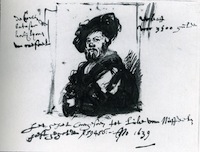 Published texts employed as teaching and learning tools by early modern artists, authors, and art patrons often bear traces of their readers’ reactions in the form of marginal notes, and artists sometimes annotated their own works — and those of others that came into their hands — with revealing comments. These documents and others like them offer a rich vein of information and insights that deserves to be better known, both for insights into particular cases and as an enduring form of reception and the practice of connoisseurship. Among cases that have attracted the greatest attention are the series of postille inscribed by Annibale Carracci in his copy of Giorgio Vasari’s Vite, examined by Charles Dempsey in 1986 and still mined for insights into the artist’s views, and Rembrandt’s annotated drawing of the Portrait of Baldassare Castiglione by Raphael, recorded along with its hammer price as the painting went up for auction in Amsterdam. Early modern collectors often made comments and even sketches in the margins of sale catalogues, adding to the value of these texts as sources of information not only about individual works and their reception, but also about networks of collectors and shifts in taste. Annotated copies of important catalogues became collectors’ items in their own right.
Published texts employed as teaching and learning tools by early modern artists, authors, and art patrons often bear traces of their readers’ reactions in the form of marginal notes, and artists sometimes annotated their own works — and those of others that came into their hands — with revealing comments. These documents and others like them offer a rich vein of information and insights that deserves to be better known, both for insights into particular cases and as an enduring form of reception and the practice of connoisseurship. Among cases that have attracted the greatest attention are the series of postille inscribed by Annibale Carracci in his copy of Giorgio Vasari’s Vite, examined by Charles Dempsey in 1986 and still mined for insights into the artist’s views, and Rembrandt’s annotated drawing of the Portrait of Baldassare Castiglione by Raphael, recorded along with its hammer price as the painting went up for auction in Amsterdam. Early modern collectors often made comments and even sketches in the margins of sale catalogues, adding to the value of these texts as sources of information not only about individual works and their reception, but also about networks of collectors and shifts in taste. Annotated copies of important catalogues became collectors’ items in their own right.
This session invites papers that explore the insights to be gained from studying annotations added to publications, drawings, and other documents by artists and art lovers of the early modern era. While printed marginalia, such as the extensive annotations that accompanied the Dutch Statenbijbel, functioned as a literary category, this session is concerned primarily with manuscript notes and sketches as a record of liminal thoughts bridging the published and the private. Papers may address individual case studies or examine broader trends from any part of Europe in the period 1550 to 1750. How might marginalia contribute to our understanding of the development of particular works, artists or trends, fluctuations in market value, or the evolution and transmission of ideas in art theory?
Please send abstracts to: Stephanie Dickey (dickey.ss@gmail.com) by April 15. All participants must become members of CAA. For format, guidelines, eligibility, etc., consult the CAA website: http://www.collegeart.org/proposals/
Stephanie Dickey
Queen’s University
Kingston, ON
Session du 104e congrès du College Art Association (CAA), Washington, DC, 3-6 février 2016.

Leave a Reply
You must be logged in to post a comment.